Fix It! Grammar from Institute for Excellence in Writing (IEW) is an amazing language arts resource that we heartily recommend to homeschool families. Here’s our honest review of the newest edition (2022) of Nose Tree and Robin Hood.
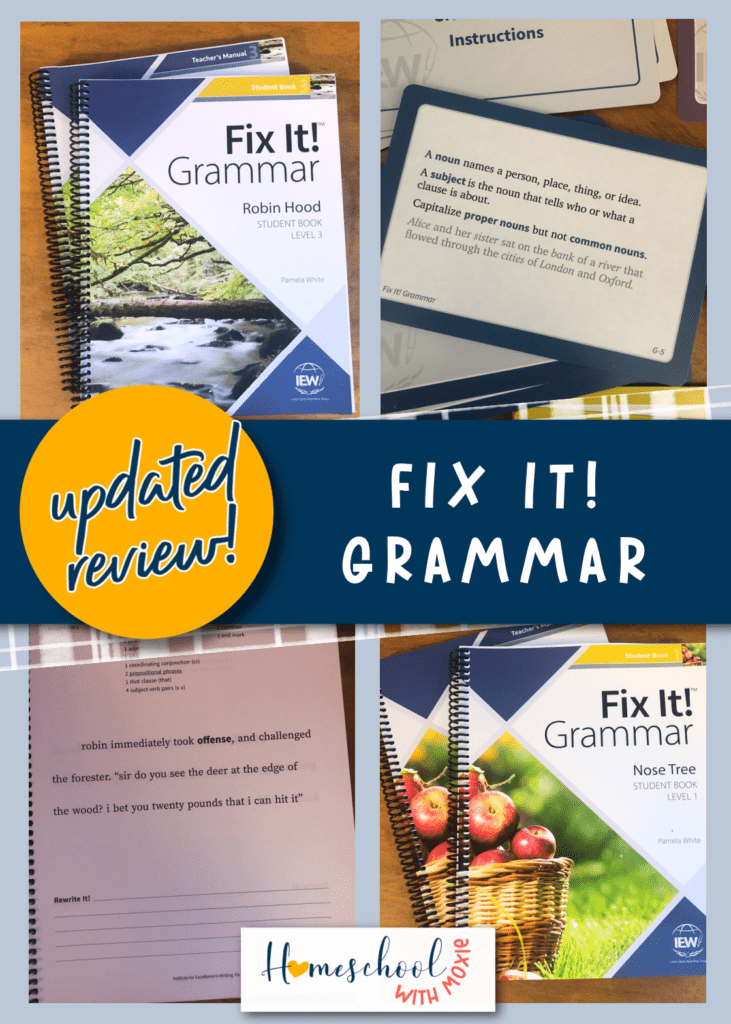
Disclaimer: I received a copy of this product in exchange for my honest review. I was not required to write a positive review, nor was I compensated in any other way. All opinions I have expressed are my own or those of my family. I am disclosing this in accordance with the FTC Regulations.
This post contains affiliate links for your convenience. I will receive a commission if you purchase from these links. Thank you.
Scope & Sequence of Fix It Grammar
The premise of this grammar program is to help students transfer grammatical knowledge into actual writing. This curriculum puts the students in the place of editors as they spend 15 minutes daily fixing sentences and looking up vocabulary and then re-writing these sentences into a notebook, which cumulatively form a cohesive story over the course of the program.
If your students are overwhelmed with grammar study, then this approach is gentle enough, yet clear enough to form a great grammar foundation. The storyline and multiple small editing tasks each day help the student to learn without experiencing grammar burnout.
If you’re looking for a complete grammar curriculum where each book builds upon the foundations set in the previous book, then definitely consider the Fix It! Grammar program. The beauty of this program is that students learn and practice grammar in a real-world context of writing, rather than marking and diagramming artificially designed sentences in a textbook.
Updated 2022 Review of Nose Tree & Robin Hood
The Fix It! Grammar series includes books at six levels to help your children learn and use grammar. Each book follows a continuing story throughout while your child uses their editing skills to “fix” each portion of text. Learning grammar in context is a helpful way for students to remember what they’ve learned. The continual review each day and building upon previous lessons ensures that your kids master the concepts.
By growing their editing skills, your kids will become better writers! We also love using the IEW themed writing books in our homeschool.
Since we previously used the older edition of Nose Tree, I could see a marked improvement with these updated editions! They are even easier to use and the layout is wonderful.
Here are the six levels:
- Nose Tree – Level 1 (grades 3-5)
- Town Mouse and Country Mouse – Level 2 (grades 3-5)
- Robin Hood – Level 3 (grades 6-8)
- Mowgli and Shere Khan – Level 4 (grades 6-8)
- Frog Prince – Level 5 (grades 9-12)
- Little Mermaid – Level 6 (grades 9-12)
You will need a student book and teacher’s manual for each level. These can be purchased separately for $19 each, or you can buy the level bundle for $29. These are spiral-bound books and so are very user-friendly as you can open them and easily focus on one page at a time.
The teacher’s manual includes a full Grammar Glossary.
Nose Tree – Level 1 (Grades 3-5)
This level 1 resource covers all eight parts of speech, plus capitalization, punctuation, clauses, and homophones. This book also teaches about subject-verb pairs and introduces stylistic techniques like using a strong verb, quality adjective, and Who/Which clauses.

Since a new vocabulary word is introduced in each day’s lesson, your student learns a total of 120 new words in this book! The best part is that they learn the words in context, and it really is painless for the student to grow their vocabulary.
Nose Tree includes 30 weeks of lessons, with a page of teaching at the beginning of each week, then four days of practice. This four days per week layout is great for homeschool families who need a more flexible schedule. Even if we miss a day, we just pick up where we left off. So, don’t worry if you don’t always start the week with “day 1.”
Here’s the new teaching for Week 9.

Then here’s the teacher’s manual page to help correct the student work on day 1 of Week 9. She’s putting into practice the new concepts. She hunts for errors in the daily passage, making corrections (fix it!) as directed at the top of the student page. She also learns to label certain grammatical concepts (mark it!) throughout each lesson. Finally, she’s asked to write the corrected passage (rewrite it!) at the bottom of the student page.
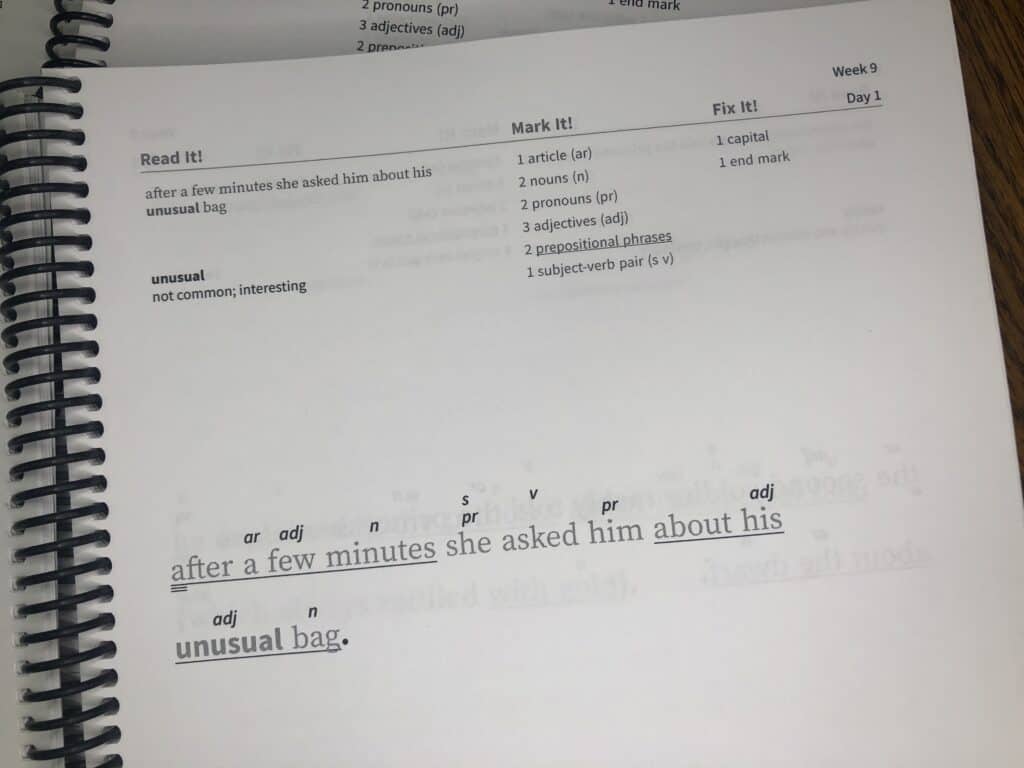
The bottom of each page in the teacher’s manual goes into more details to help you teach and discuss any concepts that are still confusing for your child. So even if you don’t feel confident in your grammar skills, you’ll be able to learn right alongside your child and help them as needed.

We love how approachable this method is for our students. It is not overwhelming, with each day’s work at just the right amount – no busy work and filling out reams of printables for no reason! Plus, instead of learning grammar rules in theory, my kids are putting them to use in real writing.
Weekly Layout + Continuing Practice
Here’s how we use it: on the first day of the week, I talk through the instruction page with my child. Then, they complete the first day’s assignment. I’ve shown them how to find the answers in the teacher’s manual so they can be independent and self-correct. I’m always here to troubleshoot or help explain confusing concepts.
But even my third grader can be mostly independent with this curriculum. We’re using this with our third grader who has had some basic introduction to the parts of speech using another curriculum.
Here’s how the first eight weeks progressed. She was able to successfully find nouns beginning in week one.
By week two, articles were introduced, and then pronouns came in week three. Once a concept is introduced, your student will practice it daily. So, week one started with finding a couple of nouns in the sentence. By week three, my daughter was finding 5 nouns, 3 pronouns, and 4 articles, in addition to adding a capital letter and end mark.
Every day also includes a vocabulary word. In week 5, the who/which clause is introduced. Homophones are brought into the lesson in week 6. And by week 7, my third grader is also finding adjectives in the daily sentence.

We love how the curriculum gives short and easy to remember clues for finding parts of speech. For example, my daughter struggled in the past with remembering that a noun “is the name of a person, place, thing, or idea.” She just couldn’t always translate the definition into finding the nouns in the sentence. But her Nose Tree book gave her two noun tests that have helped tremendously:
- The _____
- two _____
Now she can always find the nouns in the sentence!
This program has really built her grammar confidence and we will continue using IEW Fix It! Grammar for years to come.
Robin Hood – Level 3 (Grades 6-8)
This level 3 resource covers all eight parts of speech but with ever deepening clarity. So, for example, the pronoun section deep dives into more specific pronoun usage such as personal, subject, indefinite, demonstrative, and reflexive.
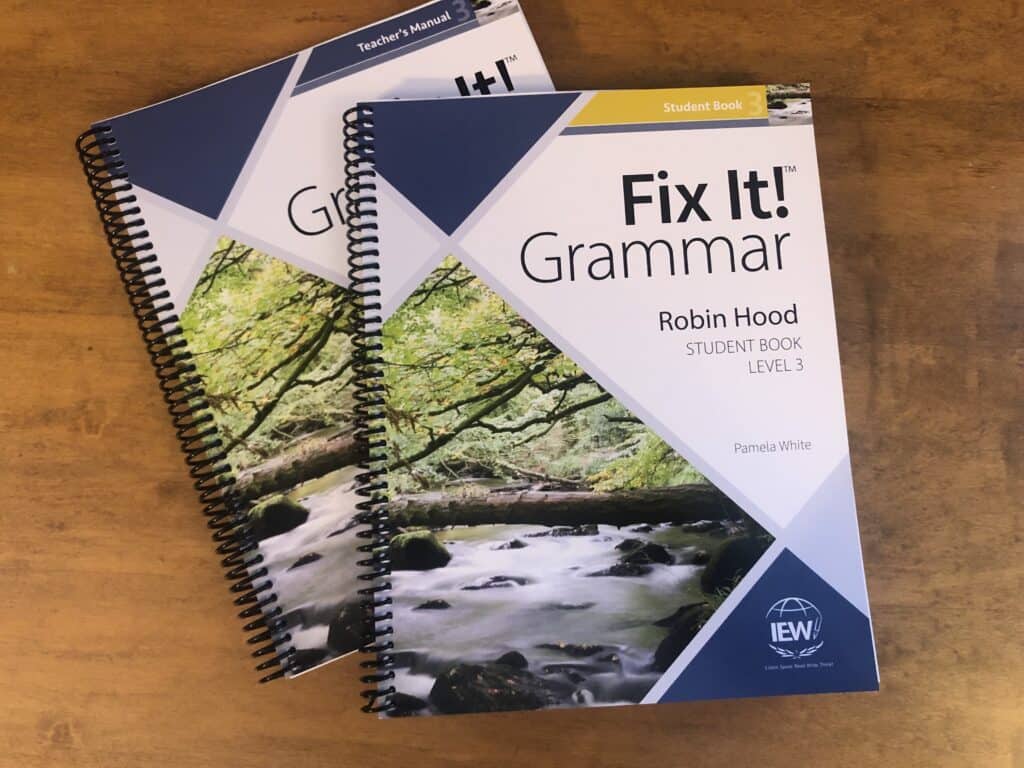
Robin Hood also includes practice in capitalization, punctuation, clauses, homophones, and many stylistic techniques. Your older student will learn to write interesting sentences and grow in their writing skills with this book. That is because multiple options for sentence openers are modeled and used in this book. We love how our students are growing in their writing skills without tears and frustration like we’ve sometimes experienced with other resources.
In addition, your level 3 student will painlessly learn 120 new vocabulary words in context of the continuing Robin Hood story.
Here’s how the new concepts are taught in the student book at the beginning of week 11. The book includes definitions, sample sentences, and helpful hints over in the margin.

Sample Week
My eighth grader is currently finishing up week 10. Here are all the items he was able to find and mark in today’s sentence.
The vocabulary word was earnestly.
He fixed these items in punctuation and sentence structure:
- 1 capital
- 2 commas
- 1 end mark
Then, he was able to correctly mark these parts of speech and other items:
- 1 article
- 3 nouns
- 2 pronouns
- 2 adverbs
- 1 coordinating conjunction
- 1 that clause
- 1 [main clause]
- 2 subject-verb pairs
- 1 opener
Do you want to know which sentence was used for all this editing and grammatical practice? Here it is before he marked it:

And after he marked all of those items, it looked like this:
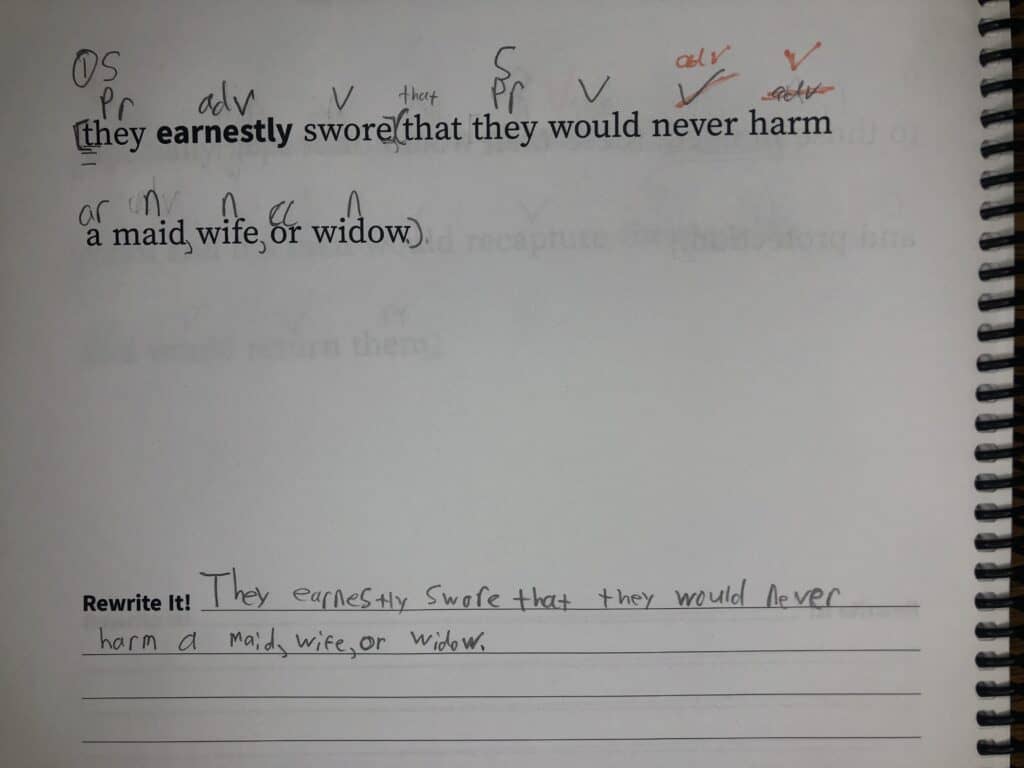
Students rewrite the corrected passage at the bottom of the student page.
Fix It! Grammar Cards
IEW also sent us the pack of Fix It! Grammar cards and these have proven very useful. Instead of having to page back in his book to remember the list of prepositions, for example, my son can just grab the preposition parts of speech card and find a handy list there.
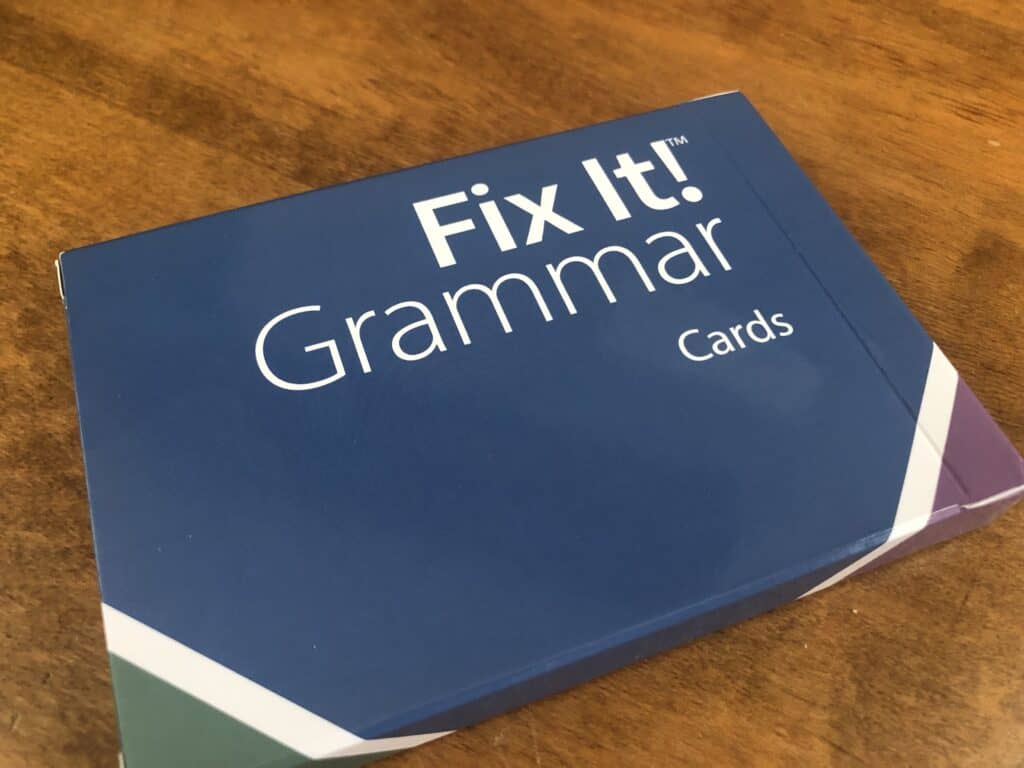
The pack includes 30 full color grammar cards for easy reference. In addition to including the 8 parts of speech, the cards cover other concepts like subject-verb pair, editing marks, clauses, quotation rules, apostrophe usage, and sentence openers.

My eighth grader is surprised with how well he understands the lessons. I love looking to the end of a book to see where we’re headed. These books contain 30 weeks of lessons. Here is the teacher’s manual answer key to the first day’s assignments of week 29. I almost couldn’t believe he would be able to find all those parts of speech! But as I see the progress he’s making through this book, I’m sure he will know all of these concepts by then.

Additional Questions About Fix It! Grammar
What grade level is Fix It! Grammar?
The Fix It! Grammar curriculum can be used by any student in any grade because it is not grade-level specific. This is a great curriculum to use with multiple ages together in your homeschool for this reason. Most students will want to start with Book 1 so that they don’t miss any foundational grammar concepts or teaching.
Is Fix It! Grammar enough?
This depends on what you are asking. Is it enough instruction in grammar? Yes, it certainly is. Is it enough to cover the entire language arts needs of your students? Remember that language arts includes grammar, but it also includes writing, spelling, and literature. Fix It! Grammar is only covering the grammar content. You will need to add additional resources for the other subjects.
Where do I start with Fix It! Grammar?
The Fix It! Grammar series is built off the book before it. So, no matter the age of your student, it is recommended that everyone starts with Book 1: Nose Tree.
Do I need the teacher’s manual?
You will probably want the teacher’s manual so that you can easily correct your student’s work.
Free Samples from IEW
We love the new editions even more! I now heartily recommend IEW’s Fix It! Grammar to families who ask for language arts curriculum options. It’s so easy to use (essential for homeschool moms), doesn’t require much time each day, and the levels are flexible – this means you could have kids in two different “grade levels” still use the same Fix It! Grammar book.
Good news! You can download and try FREE samples from IEW to see if they’re a good fit for your family.
Do the newer teacher editions still come with a downloadable student book?
Great question! The Teacher’s Manual USED to come with a downloadable student book, however this is no longer the case with the new additions. You would need to purchase a physical student book for each child. Technically you are still allowed to copy the pages of the student book for your other children, but this is only allowed within a family << (as per IEW). Hope this helps! The layout of the new edition is sooo much better, though!! We used the old Nose Tree and this updated edition is top notch.